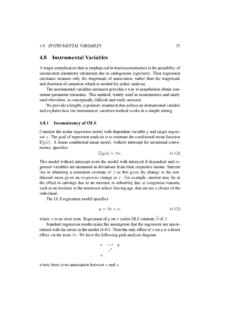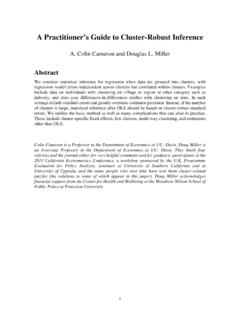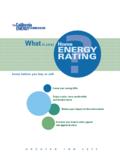Transcription of Current Issues in U.S. Health Economics: Summary for ...
1 Current Issues in Health Economics: Summary for Health Economics Course (ECN 132). Colin Cameron Department of Economics Davis Revised December 2016. The Health care industry can benefit greatly from economic analysis, especially microeconomic analysis. More than many other areas of economics this theory needs to be modified or extended to accommodate institutional features. In particular Health consumers are buying a product they know little about (information) with someone else's money (third-party payment) due to insurance (uncertainty). The big Current Issues always include the increasing cost of Health care. Colin Cameron: Health Economics Summary 2.
2 A. Overview of Health Market B. Health Insurance in the C. Theory of Health Insurance D. economic Evaluation of Health Services E. Individual Demand for Health F. Providers (Physicians, Hospitals, Pharmaceuticals). G. Government H. Medical Technology I. International Comparisons. Colin Cameron: Health Economics Summary 3. A. Overview of Health Market Total expenditures in 2014. $3,030 billion $9,500 per capita (Based on population of 316 million). of GDP (Based on GDP of $17,300 billion). Use of Funds The big three (hospital, physician, drugs&products) are 64% of total. Source of Funds 55% public and 45% private. Only 11% is out-of-pocket. Third payment is key feature of Health market.
3 Colin Cameron: Health Economics Summary 4. Trends since 1900. Expenditure risen dramatically and continuously and forecast to continue. Dramatic switch away from out-of-pocket payment to insurance. Hospital days little changed but costs much larger as more labor-intensive. More physician visits but smaller share of pie. Drugs decreased but now increasing share of pie. Nursing home care and home Health care are growth areas. Health care expenditures have risen everywhere in the world. The has the largest expenditures because of higher base and higher growth rates. Future Pressures exist for continued increase. Forecast of GDP in 2020. At same time is a real outlier and radical change is possible.
4 Colin Cameron: Health Economics Summary 5. Use of Funds in 2014. Category % of Total Trend since 1960 Biggest Issues Hospital 32 Static Managed care; technology Physician & clinical 20 Static Managed care; physician income Drugs & Supplies 13 Up Formularies; technology Other professional 11. Nursing Home 5 Up Home Health 3 Up Administration costs 7 Up Standardization Public Health 3 Up Research 2 Down Switch from government to private Construction 4. Total 100. Colin Cameron: Health Economics Summary 6. Source of Funds in 2014. Category % of Total Biggest Issues Public (55%). Medicare 22 Insolvency; consumer choice; drugs Medicaid 17 States; managed care; elderly poor; children Other public 15.
5 Private (45%). Private insurance 31 Employers providing less; reaching uninsured;. Future of Obamacare. Out-of-pocket 11. Other private 4. Total 100. Colin Cameron: Health Economics Summary 7. B. Health Insurance in the General Principles Risk-pooling is the reason insurance works. Risk-aversion is the reason consumers purchase insurance. Adverse-selection can lead to failure of insurance markets Moral hazard can lead to welfare loss due to excess consumption of Health services (Paully, and Manning et al RAND study). Health Insurance Terminology Copayment a lump sum paid by insured per service $20. Coinsurance a percentage paid by insured per service 10%.
6 Deductible an annual amount paid before any insurance cover $2,000. Premia the price of a Health insurance policy. Pre-existing conditions Health conditions that may not be covered. Colin Cameron: Health Economics Summary 8. Rand Health Insurance Experiment The RAND study in the late 1970's randomly gave individuals Health insurance policies with varying coinsurance rates. Finds that demand for medical services responds to price. Arc price elasticity ranged from to Health Insurance Coverage Much insurance is employment-related or government provided. 33 million in 2011 or 10% were not covered by insurance. Colin Cameron: Health Economics Summary 9.
7 Types of Health Insurance FFS Fee for service - insured has great choice of treatment and provider - now disappeared but was dominant until 1990's. HMO Health maintenance organization - restricted choice of treatment and provider - introduced in 1980's, peaked in 1996, much less now. PPO preferred provider organization - choice less restricted than HMO but much more than FFS. - introduced in 1990's, most common form now. HDHP high deductible Health plan - much higher deductibles, copays than traditional HMO, PPO. - highly tax favored with Health savings account (HCA) option - introduced in mid 2000's and increasingly popular. Colin Cameron: Health Economics Summary 10.
8 Recent Trends in Health Insurance Switch from indemnity FFS to managed care (PPO and HMO). Percentage uninsured up in early 1990's, down in late 1990's, rising in 2000's again. Obama's Affordable Care Act took effect in 2014, including insurance exchanges, individual mandates, no pre-existing conditions exclusions. Future Insurance is a key choice variable of consumers and is price-responsive. Movement to encourage insurance with higher copays and use of medical savings accounts to permit tax deductibility of out-of-pocket payments. Access to insurance for those not covered by government or employer insurance plans. Colin Cameron: Health Economics Summary 11.
9 Managed Care Quality and Quantity Very fast growth with indemnity insurance essentially eliminated. Recent anecdotal criticisms of access to care (quality and quantity) have led to actual reduction in HMO, so PPO is now dominant in much of Studies indicate much of the care in managed care is good (Miller and Luft). Based on difference-in-means tests. Costs One-time cost savings of 10-20 % (controlling for favorable selection into HMOs). Trend then appears to be same as non-managed care. High costs relative to premia has led to failure of managed care companies. Colin Cameron: Health Economics Summary 12. Test Difference between two means ( for FFS versus HMO).
10 HMO X1 = s X 1 = FFS X2 = s X 2 = Then t = ( X 1 - X 2 ) / sqrt(s X 12 + s X 22 ). = ( ) / sqrt( + ). = - / sqrt ( ) = - / = - Since |t| = > we reject H0: = . Conclude that there is a statistically significant difference at 5%. Colin Cameron: Health Economics Summary 13. Government Insurance: Medicare For those aged over 65 + disabled + end-point renal disease. Established in 1965 (parts A (hospital) & B (physician & outpatient). Federal program funded by payroll tax More recently Parts C (advantage) and D (pharmaceuticals) added Government Insurance: Medicaid For those poor Established in 1965. Federal / state program financed out of general revenue Includes nursing home for elderly (not covered by Medicare).)









